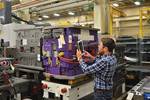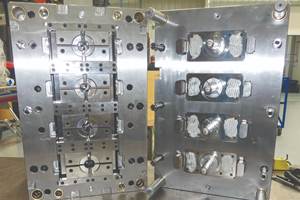Using Data to Improve Mold Performance
An easy way to get a snapshot of how a mold is operating is to run regular mold scans via a hot runner temperature controller.
Most molders use their hot runner temperature controllers for just that: temperature control. They know that soft starts are helpful in preventing short circuits, and alarms will sound when there is a broken thermocouple. But how do maintenance and tooling managers confront the issue of poorly performing molds or, even worse, a broken heater or material leaks? While it may be impossible to predict when these events will take place, preventive maintenance (PM) or input from the injection floor can mitigate some of these problems and avoid catastrophic failures.
Not everyone can afford to have a full-time employee constantly running PM on tools. One of the easiest ways for a company to get a snapshot of how a mold is operating is to run a mold scan daily or even weekly via a hot runner temperature controller that records the electrical properties of a mold on a zone-by-zone basis, reading wattage, gradient, amperage and resistance. Storing this information then allows a shop’s maintenance department to see if any of these values change over time as the tool experiences more wear and tear. A proper mold scan can flag infiltration and/or probe degradation problems like pinches and discontinuities.
Running a proper mold scan upon a mold’s arrival in a shop will inform the maintenance department about how the mold should act before it goes into use on the shop floor. It is recommended that a full scan of the mold be conducted when it is out of production, calculating wattage, amperage and resistance, as well as temperature gradient. The temperature gradient is only calculated as the mold initially heats, and this is why the mold must be cooler than 80°C in order for a full mold scan to be accurately completed. A quick diagnostic can be done during production to calculate the aforementioned items, with the exception of the temperature gradient.
Scans and diagnostics will tell the maintenance department which areas of the mold to closely monitor. When parts are not meeting quality standards, a mold scan can often confirm a suspicion that something is happening in a specific mold section. And if any of the zones fall out of a preset tolerance, those zones will trigger an alarm. This alarm can stop the press or simply serve as an audible signal to a technician that something is awry. The technician can then decide if intervention is necessary.
For example, say a technician is seeing temperature drifts on a certain zone during production. By putting this zone under surveillance, he might notice large power fluctuations, which are most likely caused by a material leak. Without power monitoring, the technician may not notice that it takes 50 percent power to reach setpoint instead of a more manageable 5 to 10 percent. A multizone controller can alert a shop to this problem by sending out an alarm if the power consumption is out of tolerance by more than 10 percent on any given zone. Using this type of CPU-based system will put less strain on the heaters and signal someone to check on the mold.
Any number of electrical problems can sporadically arise within mold operation, but by using a mold scan, maintenance and tooling departments can get ahead of problems before they become critical.
Related Content
The Ins and Outs of Hot Runner Temperature Control
A training checklist that explains the why and how of proper hot runner temperature control and system management.
Read MoreHow to Use Thermal Management to Improve Mold Cooling
A review of common mold cooling issues and possible solutions, including 3D printing applications.
Read MorePortable Low-Heat, Non-Arcing Resistance Welder for Mold Repair
Rocklin’s user-friendly MoldMender Micro Welder delivers simple and cost-effective localized repair in-house with precision and versatility, enhancing mold and die durability and reducing disassembly and downtime.
Read MorePrecision Welding Services Offer Rapid Turnaround Mold Repair and Reduced Molder Downtime
X-Cell Tool & Mold relies on outsourced, high-quality welding repairs from Lewis-Bawol Welding to ensure its customers' molds are back in production quickly and affordably.
Read MoreRead Next
The Data-Driven Operation
Manufacturing is a team effort involving suppliers, tool shops and customers throughout the world collaborating and sharing project data.
Read MoreHow to Use Strategic Planning Tools, Data to Manage the Human Side of Business
Q&A with Marion Wells, MMT EAB member and founder of Human Asset Management.
Read MoreAre You a Moldmaker Considering 3D Printing? Consider the 3D Printing Workshop at NPE2024
Presentations will cover 3D printing for mold tooling, material innovation, product development, bridge production and full-scale, high-volume additive manufacturing.
Read More












.jpg;maxWidth=300;quality=90)








